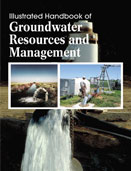Handbooks

Hydrologic stresses throughout the 20th century and presently have caused the depletion and degradation of vital ground-water resources in many areas. Groundwater Resources and Management provides an authoritative, comprehensive treatment of groundwater resources development and management, offering sustainability methods and detailed principles on groundwater protection and restoration. Groundwater differs from surface water because of the contrasting physical and chemical environment in which it occurs, although the water itself is essentially part of the same overall cycle. Groundwater resources management has to deal with balancing the exploitation of a complex resource (in terms of quantity, quality and surface water interactions) with the increasing demands of water and land users (who can pose a threat to resource availability and quality). This illustrated handbook deals with the quantitative, essentially resource-related, issues of groundwater management, and only touches marginally upon groundwater pollution protection.
Water is an essential resource for all life on the planet. Of the water resources on Earth only three percent of it is fresh and two-thirds of the freshwater is locked up in ice caps and glaciers. Of the remaining one percent, a fifth is in remote, inaccessible areas and much seasonal rainfall in monsoonal deluges and floods cannot easily be used. As time advances, water is becoming scarcer and having access to clean, safe, drinking water is limited among countries. Due to the small percentage of water remaining, optimizing the fresh water we have left from natural resources has been a continuous difficulty in several locations worldwide. Groundwater has emerged as the primary democratic water source and poverty reduction tool in rural areas. On account of its near universal availability, dependability and low capital cost, it is the most preferred source of water to meet the requirements of various user sectors. Ground water has made significant contributions to the growth of Economy and has been an important catalyst for its socio economic development.
The increasing dependence on ground water as a reliable source of water has resulted in its large-scale and often indiscriminate development, without due regard to the recharging capacities of aquifers and other environmental factors. Illustrated Handbook of Groundwater Resources and Management deals comprehensively with the fundamental principles for understanding the hydrogeology and hydrologic processes. The increasing dependence on ground water as a reliable source of water has resulted in indiscriminate extraction in various parts of the world without due regard to the recharging capacities of aquifers and other environmental factors. On the other hand, there are some areas, where ground water development is sub-optimal in spite of the availability of sufficient resources, and canal command areas suffering from problems of water logging and soil salinity due to the gradual rise in ground water levels. The unplanned and non-scientific development of ground water resources, mostly driven by individual initiatives has led to an increasing stress on the available resources. The adverse impacts can be observed in the form of long-term decline of ground water levels, de-saturation of aquifer zones, increased energy consumption for lifting water from progressively deeper levels and quality deterioration due to saline water intrusion in coastal areas in different parts of the country. In order to address various issues related to ground water, keeping in view the climatic change, there is a need to prepare a comprehensive road map with identified strategies for scientific and sustainable management of the available ground water resources in order to avert the looming water crisis. Illustrated Handbook of Groundwater Resources and Management explores various aspects of groundwater monitoring and management for students and researchers towards the sustainability of groundwater resources.